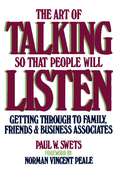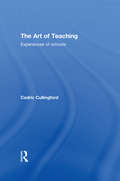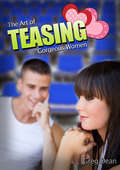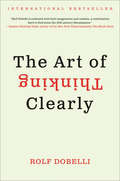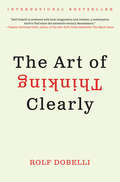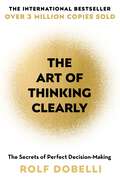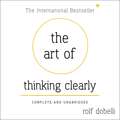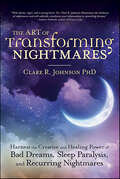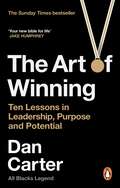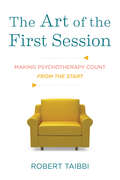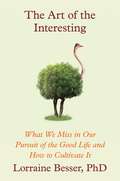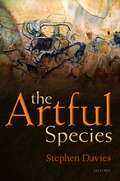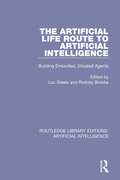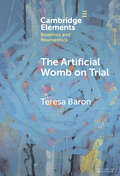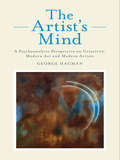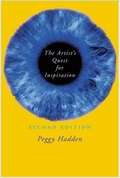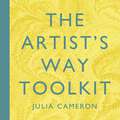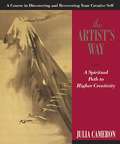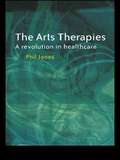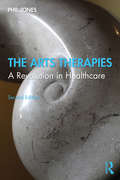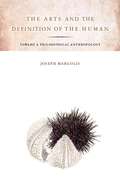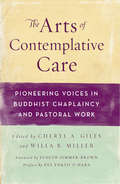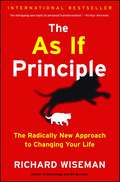- Table View
- List View
The Art of Talking So That People Will Listen
by Paul W. SwetsTalking comes naturally...but getting people to listen is an art. This brand-new guide provides you with practical, proven strategies for mastering the art of effective, persuasive communication the--skill most essential to your enjoyment of other people and the achievement of personal success.
The Art of Teaching: Experiences of Schools
by Cedric CullingfordA central dilemma for teachers is finding ways to deal with the multiple perspectives and demands of pupils, parents, school management, and external forces. The Art of Teaching explores the tension between teaching and learning that all teachers face. Presenting a series of insights into the art of teaching from the perspectives of those individuals most closely involved in the schooling process, the book explores pupil voice in schools, and experiences of teaching and learning from the pupil perspective. Providing an opportunity for self reflection, the book also examines teachers’ relationships with parents, external agencies and their attitudes towards pupils. Subjects covered include: What pupils think of teachers Teacher’s views of themselves and self reflection School hierarchies and the ethos of inspection Using pupil insights to inform learning strategies Essential reading for all teachers and students, this book offers a unique insight into school relationships and structures, giving readers an awareness of what is like to be a teacher. Professor Cedric Cullingford’s many books include "The Causes of Exclusion" (Taylor and Francis) and "How Pupils Cope with School" (Cambridge Scholar’s Press).
The Art of Teasing Gorgeous Women
by Greg DeanFinally, a dating advice book that teaches you how to hold your ground when you don't know how to handle the confidence and tests of gorgeous women.Make a gorgeous woman laugh through flirting and teasing and you can capture her heart. This book full of dating advice for men will show you how.Gorgeous women have heard it all before:"You are so beautiful.""You have the most beautiful eyes.""Wow, you have a really sexy body."The compliments bore them when they come from men who are way too easy to obtain.This easy-to-follow guide will teach you:- Sexual confidence- To have a complete lack of neediness- To convey you are popular, fun and very funny, even if you're not- How to handle virtually any conversation with gorgeous women so you appear strong, cocky and awesome to be with.Renowned date coach, Greg Dean gives you the vital blueprint you need to create stunning attraction between you and the gorgeous woman you are falling for.Men love compliments. Women love to be teased and challenged. So if you want to attract beautiful women, you must take another tact.Too many guys play too nice or go way too far. This book teaches you that perfect balance. It will teach you to grow your own style but provides a complete back up system when you need to challenge her on the spot in a fun, friendly, confident way.This guide is an absolute must for any guy who gets nervous around gorgeous women, conveys way too much interest and constantly gets friend zoned, or worse, ignored.If you want the best possible chance to get the gorgeous girl and you don't know how to really handle yourself, this instruction book will show you what to say to her and give you the best possible chance at success.Confident, gorgeous women love to be teased and challenged in a loving, fun way. This is the art of teasing gorgeous women.
The Art of Thinking Clearly
by Rolf DobelliHave you ever . . . Invested time in something that, in hindsight, just wasnt worth it? Paid too much in an eBay auction? Continued to do something you knew was bad for you? Sold stocks too late, or too early? Taken credit for success, but blamed failure on external circumstances? Backed the wrong horse?These are examples of what the author calls cognitive biases, simple errors all of us make in day-to-day thinking. But by knowing what they are and how to identify them, we can avoid them and make better choices: whether in dealing with personal problems or business negotiations, trying to save money or earn profits, or merely working out what we really want in life--and strategizing the best way to get it. Already an international bestseller, The Art of Thinking Clearly distills cutting-edge research from behavioral economics, psychology, and neuroscience into a clever, practical guide for anyone whos ever wanted to be wiser and make better decisions. A novelist, thinker, and entrepreneur, Rolf Dobelli deftly shows that in order to lead happier, more prosperous lives, we dont need extra cunning, new ideas, shiny gadgets, or more frantic hyperactivity--all we need is less irrationality. Simple, clear, and always surprising, this indispensable book will change the way you think and transform your decision making--at work, at home, every day. From why you shouldnt accept a free drink to why you should walk out of a movie you dont like, from why its so hard to predict the future to why you shouldnt watch the news, The Art of Thinking Clearly helps solve the puzzle of human reasoning.
The Art of Thinking Clearly
by Rolf DobelliHave you ever . . . Invested time in something that, in hindsight, just wasn't worth it? Paid too much in an eBay auction? Continued to do something you knew was bad for you? Sold stocks too late, or too early? Taken credit for success, but blamed failure on external circumstances? Backed the wrong horse?These are examples of what the author calls cognitive biases, simple errors all of us make in day-to-day thinking. But by knowing what they are and how to identify them, we can avoid them and make better choices: whether in dealing with personal problems or business negotiations, trying to save money or earn profits, or merely working out what we really want in life--and strategizing the best way to get it.Already an international bestseller, The Art of Thinking Clearly distills cutting-edge research from behavioral economics, psychology, and neuroscience into a clever, practical guide for anyone who's ever wanted to be wiser and make better decisions. A novelist, thinker, and entrepreneur, Rolf Dobelli deftly shows that in order to lead happier, more prosperous lives, we don't need extra cunning, new ideas, shiny gadgets, or more frantic hyperactivity--all we need is less irrationality.Simple, clear, and always surprising, this indispensable book will change the way you think and transform your decision making--at work, at home, every day. From why you shouldn't accept a free drink to why you should walk out of a movie you don't like, from why it's so hard to predict the future to why you shouldn't watch the news, The Art of Thinking Clearly helps solve the puzzle of human reasoning.
The Art of Thinking Clearly: Better Thinking, Better Decisions
by Rolf DobelliTHE SECRET TO PERFECT DECISION-MAKING'This book will change the way you think' Dan Goldstein, London Business SchoolHave you ever... Invested time in something that, with hindsight, just wasn't worth it? Overpaid in an Ebay auction? Continued doing something you knew was bad for you? Backed the wrong horse?THE ART OF THINKING CLEARLY is essential reading for anyone with important decisions to make. It reveals, in 100 short chapters, the most common errors of judgement, and how to avoid them. Simple, clear and always surprising, this indispensable book will change the way you think and transform your decision-making - at work, at home, every day.SUNDAY TIMES BESTSELLER * GUARDIAN BESTSELLER * INTERNATIONAL BESTSELLER
The Art of Thinking Clearly: Better Thinking, Better Decisions
by Rolf DobelliTHE SUNDAY TIMES BESTSELLERTHE TIMES BESTSELLERMAIL ON SUNDAY BESTSELLERGUARDIAN BESTSELLER AMAZON TOP TEN BESTSELLERLIVE MAGAZINE BESTSELLERIRISH TIMES NUMBER 1 BESTSELLERTHE SECRETS OF PERFECT DECISION-MAKINGHave you ever...Invested time in something that, with hindsight, just wasn't worth it?Overpayed in an Ebay auction?Continued doing something you knew was bad for you?Sold stocks too late, or too early?Taken credit for success, but blamed failure on external circumstances?Backed the wrong horse?These are examples of cognitive biases, simple errors we all make in our day-to-day thinking. But by knowing what they are and how to spot them, we can avoid them and make better choices - whether dealing with a personal problem or a business negotiation; trying to save money or make money; working out what we do or don't want in life, and how best to get it.Already an international bestseller, THE ART OF THINKING CLEARLY is essential reading for anyone with important decisions to make. It reveals, in 100 short chapters, the most common errors of judgement, and how to avoid them. Simple, clear and always surprising, this indispensable book will change the way you think and transform your decision-making - at work, at home, every day.(P)2013 Hodder & Stoughton
The Art of Transforming Nightmares: Harness the Creative and Healing Power of Bad Dreams, Sleep Paralysis, and Recurring Nightmares
by Clare R. JohnsonTransform Nightmares into Healing, Creative, Spiritual GiftsThe Art of Transforming Nightmares is a friendly, hands-on guide to help you tap into the immensely rich gifts that bad dreams offer up when we work with them in healing ways. Dr. Clare Johnson, world-leading expert on lucid dreaming, shares her best practical tips for overcoming nightmares and a unique quiz that identifies your personal sleeper-dreamer type so you can fast-track to the transformative techniques that work best for you.With forty-five practices and fifteen tailor-made nightmare solution programs, this guidebook helps you set up your own unique program for transforming your dream life. It shares practical tools to reduce nightmare frequency, manage sleep paralysis, resolve distressing dreams, and release fear. You'll tap into the deep wisdom of your unconscious mind and discover how to transform your night of sleep into a beautiful, healing refuge so that you wake up energized and ready to lead a life of happiness and wonder.
The Art of Winning: Ten Lessons in Leadership, Purpose and Potential
by Dan CarterDan Carter is a widely hailed as one of the most elite and successful professional rugby players in the world.After retiring from a sport he played for 32 years, he set out to inspire the next generation of leaders to create purposeful impact, joining the Oxford Foundry - Oxford University's Entrepreneurial Institute, founded by LinkedIn co-found Reid Hoffman - as its first ever Leader in Practice. Now, in a follow-up to his bestselling 2015 autobiography, he answers timeless questions for aspiring leaders everywhere. Why is the team more important than the individual? How do you navigate the transition from player to leader? How should we respond when confidence is eclipsed by doubt, when circumstances get the better of us, when setbacks derail us? How can we remain humble and grounded when we're winning - and how can we keep on winning, even when a loss may be just around the corner?Full of inspiring personal stories of both victories and setbacks, the greatest rugby sportsman reflects on his career, shares his own secrets of high performance, and reveals the art of exceeding your highest expectations.
The Art of the First Session: Making Psychotherapy Count From the Start
by Robert TaibbiMaking Psychotherapy Count from the Start The average client today only comes to therapy five to eight times, and many only come once, so it is increasingly important, therefore, for therapists to achieve first-session success. Therapeutic skills and sales and marketing savvy are equally important to this task. In the first sixty minutes, clinicians must build trust, communicate what they have to offer, and ensure that the client feels different when they walk out than they did walking in. Short, practical, and applicable to all therapeutic modalities, this book walks readers through all the first-session essentials, including preparation for the first session, action-steps for each stage of the session, techniques for changing the emotional climate, and “closing the deal,” to make sure that clients come back for more. Packed with case examples, vignettes, tools, and techniques, The Art of the First Session prepares clinicians with critical skills to cut through performance anxiety, feel and convey confidence with clients, and hit the ground running in therapy with new clients.
The Art of the Interesting: What We Miss in Our Pursuit of the Good Life and How to Cultivate It
by Lorraine BesserPhilosopher and popular Middlebury professor Dr. Lorraine Besser reveals the missing third piece in our search for the Good Life—what she calls The Interesting—and teaches us how to cultivate it in our lives. Do you know anyone who's truly living The Good Life? Traditionally, philosophers and psychologists have thought of the Good Life in terms of happiness or meaning, or some combination of both. But, if it&’s really that simple, if all you need is more happiness or meaning to get to the Good Life, why aren&’t more of us achieving that truly &“good&” life? You&’ve hit all the traditional markers, jumped on the happiness train, committed to a gratitude practice, sought purpose in your work, and yet The Good Life you&’re seeking, is still out of reach. Emerging research is revealing that there is, in fact, more to the good life than the current —and even ancient—conversation suggests. This has been identified as psychological richness. Dr. Lorraine Besser, a founding investigator in these studies, shows how psychological richness helps to make our Good Lives more interesting. Interesting experiences captivate our minds, engage our thoughts and emotions, and often change our perspective. What&’s interesting is different for everyone, and everyone can obtain and strengthen the skills necessary to access the interesting. In this illuminating book, you&’ll take a deeper dive into the ways that you can cultivate the interesting in your everyday life, including: How to develop an interesting mindset How to harness the power of novelty How to turn obstacles into adventures Through delightful stories, powerful tools, and new mindsets, you&’ll learn how to &“keep it interesting.&” Whether you feel like something is missing from your life, or you&’re yearning for more, Besser's groundbreaking manifesto will guide you toward a fuller, more satisfying life.
The Art of the Psychotherapist (A Norton Professional Book)
by James BugentalUnlike the brief, specific-solution oriented therapies that many people demand today, the goal of depth therapy is life change. James Bugental has been practicing, teaching and writing about depth therapy for 40 years, and in this book, he shares his experiences as a psychotherapist.
The Artful Species: Aesthetics, Art, And Evolution
by Stephen DaviesThe Artful Species explores the idea that our aesthetic responses and art behaviors are connected to our evolved human nature. Our humanoid forerunners displayed aesthetic sensibilities hundreds of thousands of years ago and the art standing of prehistoric cave paintings is virtually uncontested. In Part One, Stephen Davies analyses the key concepts of the aesthetic, art, and evolution, and explores how they might be related. He considers a range of issues, including whether animals have aesthetic tastes and whether art is not only universal but cross-culturally comprehensible. Part Two examines the many aesthetic interests humans take in animals and how these reflect our biological interests, and the idea that our environmental and landscape preferences are rooted in the experiences of our distant ancestors. In considering the controversial subject of human beauty, evolutionary psychologists have traditionally focused on female physical attractiveness in the context of mate selection, but Davies presents a broader view which decouples human beauty from mate choice and explains why it goes more with social performance and self-presentation. Part Three asks if the arts, together or singly, are biological adaptations, incidental byproducts of nonart adaptations, or so removed from biology that they rate as purely cultural technologies. Davies does not conclusively support any one of the many positions considered here, but argues that there are grounds, nevertheless, for seeing art as part of human nature. Art serves as a powerful and complex signal of human fitness, and so cannot be incidental to biology. Indeed, aesthetic responses and art behaviors are the touchstones of our humanity.
The Artificial Life Route to Artificial Intelligence: Building Embodied, Situated Agents (Routledge Library Editions: Artificial Intelligence #9)
by Rodney Brooks Luc SteelsOriginally published in 1995, this volume is the direct result of a conference in which a number of leading researchers from the fields of artificial intelligence and biology gathered to examine whether there was any ground to assume that a new AI paradigm was forming itself and what the essential ingredients of this new paradigm were. A great deal of scepsis is justified when researchers, particularly in the cognitive sciences, talk about a new paradigm. Shifts in paradigm mean not only new ideas but also shifts in what constitutes good problems, what counts as a result, the experimental practice to validate results, and the technological tools needed to do research. Due to the complexity of the subject matter, paradigms abound in the cognitive sciences -- connectionism being the most prominent newcomer in the mid-1980s. This workshop group was brought together in order to clarify the common ground, see what had been achieved so far, and examine in which way the research could move further. This volume is a reflection of this important meeting. It contains contributions which were distributed before the workshop but then substantially broadened and revised to reflect the workshop discussions and more recent technical work. Written in polemic form, sometimes criticizing the work done thus far within the new paradigm, this collection includes research program descriptions, technical contributions, and position papers.
The Artificial Womb on Trial (Elements in Bioethics and Neuroethics)
by Teresa BaronArtificial womb technology is approaching over the scientific horizon. Recent proof-of-principle experiments using foetal animals have prompted a new surge of bioethical interest in the topic: scholars have asked what ectogenesis would mean for individuals, family, oppressed groups, and society at large; how we can or should regulate the technology; and whose interests motivate ectogenic research. However, a full investigation of the bioethics of ectogenesis must ask, 'how do we get there?' This Element places the research and development process itself under the microscope and explores the bioethical issues raised by human subject trials of ectogenic prototypes. This title is also available as Open Access on Cambridge Core.
The Artist's Mind: A Psychoanalytic Perspective on Creativity, Modern Art and Modern Artists
by George HagmanFor the past century psychoanalysts have attempted to understand the psychology of art, artists and aesthetic experience. This book examines how contemporary psychoanalytic theory provides insight into understanding the psychological sources of creativity, Modern Art and modern artists. The Artist’s Mind revisits the lives of eight modern artists including Henri Matisse, Marcel Duchamp, Jackson Pollock and Andy Warhol, from a psychoanalytical viewpoint. It looks at how opportunities for a new approach to art at the turn of the twentieth century offered artists a chance to explore different forms of creativity and artistic ambition. Key areas of discussion include: developmental sources of the aesthetic sense psychological functions of creativity and art psychology of beauty, ugliness and the Sublime. co-evolution of the modern self, modernism and art. cultural context of creativity, artistic identify and aesthetic experience. Through the examination of great artists’ lives and psychological dynamics, the author articulates a new psychoanalytic aesthetic model that has both clinical and historical significance. As such this book is essential reading for all those with an interest in the origins and fate of Modern Art.
The Artist's Quest of Inspiration
by Peggy HaddenUpdated to inspire a new generation of visual artists in their quest for creative growth, this book shows artists how they can experience a new awakening of creativity and add fresh meaning to their work by using simple techniques found in this inspirational guide. A working artist who has coped successfully with the daily challenge of facing a blank canvas shares her methods for overcoming creative blocks.Allworth Press, an imprint of Skyhorse Publishing, publishes a broad range of books on the visual and performing arts, with emphasis on the business of art. Our titles cover subjects such as graphic design, theater, branding, fine art, photography, interior design, writing, acting, film, how to start careers, business and legal forms, business practices, and more. While we don't aspire to publish a New York Times bestseller or a national bestseller, we are deeply committed to quality books that help creative professionals succeed and thrive. We often publish in areas overlooked by other publishers and welcome the author whose expertise can help our audience of readers.
The Artist's Way Toolkit: How to Use the Creative Practices
by Julia CameronHailed as the Queen of Creativity, Julia Cameron is the authority on artistic life and has brought her wisdom to millions around the world. The four essential, accessible tools she has been famed for over her lifelong career-MorningPages, Artist Dates, Walks and Guidance- have transformed lives. Now, for the first time, they are presented together, along with her readers' most commonly asked questions.Offering a deep dive into each tool, Cameron demonstrates how to set ourselves firmly on path to self-love and creative nourishment. Thanks to the learned experience of a lifetime of teaching and writing about creative recovery, she generously delivers inspiring stories and practices to guide us back to discovery.
The Artist's Way, A Spiritual Path to Higher Creativity
by Julia CameronThe Artist's Way is the seminal book on the subject of creativity. An international bestseller, it's an invaluable guide to living the artist's life. Perhaps even more vital in today's cultural climate than when it was first published a decade ago, it is a powerfully provocative and inspiring work. In a new introduction to the book, Julia Cameron reflects on the impact of The Artists Way and describes her work over the last decade and the deep insights into the creative process she has gained. Now updated, this anniversary edition ushers The Artist's Way into a new century. JULIA CAMERON has been an active artist for more than thirty years. She is the author of seventeen books, fiction and nonfiction, including The Artist's Way, The Vein of Gold, and The Right to Write, her bestselling works on the creative process. A novelist, playwright, songwriter, and poet,she has multiple credits in theater, film, and television. She divides her time between Manhattan and the high desert of New Mexico.
The Arts Therapies: A Revolution in Healthcare
by Phil JonesThe Arts Therapies provides, in one volume, a guide to the different disciplines and their current practice and thinking. It presents:* A clear analysis of the relationship between client, therapist and art form.* An exploration of research, practice and key contributions made to the field by practitioners internationally and within many different contexts.* Discussion of how the arts therapies relate to established health services.The Arts Therapies: A revolution in healthcare is a unique book that provides a thorough and up-to-date overview of the arts therapies. It will prove invaluable to arts therapists, health professionals, and all those who wish to learn more about the field.
The Arts Therapies: A Revolution in Healthcare
by Phil JonesThe separate arts therapies – drama, art, music and dance – are becoming available to increasing numbers of clients as mental health professionals discover their potential to reach and help people. But what are the arts therapies, and what do they offer clients? This fully updated new edition of The Arts Therapies provides, in one volume, a guide to the different disciplines and their current practice and thinking in different parts of the world. Each chapter draws on a variety of perspectives and accounts to develop understandings of the relations between theory, research and practice, offering perspectives on areas such as the client-therapist-art form relationship or on outcomes and efficacy to help articulate and understand what the arts therapies can offer specific client groups. This new edition features ‘Focus on Research’ highlights from music therapy, art therapy, dramatherapy and dance movement therapy, which offer interviews with researchers in China, Africa, South America, Australia, Europe and North America, exploring significant pieces of enquiry undertaken within recent years. This comprehensive overview will be an essential text for students and practitioners of the arts therapies. It is international in scope, fully up-to-date with innovations in the field and will be relevant to new practitioners and those looking to deepen their understanding.
The Arts and the Definition of the Human
by Joseph MargolisThe Arts and the Definition of the Humanintroduces a novel theory that our selves-our thoughts, perceptions, creativity, and other qualities that make us human-are determined by our place in history, and more particularly by our culture and language. Margolis rejects the idea that any concepts or truths remain fixed and objective through the flow of history and reveals that this theory of the human being (or "philosophical anthropology") as culturally determined and changing is necessary to make sense of art. He shows that a painting, sculpture, or poem cannot have a single correct interpretation because our creation and perception of art will always be mitigated by our historical and cultural contexts. Calling upon philosophers ranging from Parmenides and Plato to Kant, Hegel, and Wittgenstein, art historians from Damisch to Elkins, artists from Van Eyck to Michelangelo to Wordsworth to Duchamp, Margolis creates a philosophy of art interwoven with his philosophical anthropology which pointedly challenges prevailing views of the fine arts and the nature of personhood.
The Arts of Contemplative Care
by Judith Simmer-Brown Pat Enkyo O'Hara Cheryl A Giles Willa B MillerPowerful and life-affirming, this watershed volume brings together the voices of pioneers in the field of contemplative care--from hospice and hospitals to colleges, prisons, and the military. Illustrating the day-to-day words and actions of pastoral workers, each first-person essay in this collection offers a distillation of the wisdom gained over years of compassionate experience. The stories told here are sure to inspire--whether you are a professional caregiver or simply feel inclined toward guiding, healing, and comforting roles. If you are inspired to read this book, or even one touching story in it, you just might find yourself inspired to change a life.
The Arts of Contemplative Care: Pioneering Voices in Buddhist Chaplaincy and Pastoral Work
by Judith Simmer-Brown Pat Enkyo O'Hara Cheryl A Giles Willa B MillerPowerful and life-affirming, this watershed volume brings together the voices of pioneers in the field of contemplative care--from hospice and hospitals to colleges, prisons, and the military. Illustrating the day-to-day words and actions of pastoral workers, each first-person essay in this collection offers a distillation of the wisdom gained over years of compassionate experience. The stories told here are sure to inspire--whether you are a professional caregiver or simply feel inclined toward guiding, healing, and comforting roles. If you are inspired to read this book, or even one touching story in it, you just might find yourself inspired to change a life.
The As If Principle
by Richard WisemanVictorian philosopher William James had a theory about emotion and behavior: It isn't that our feelings guide our actions (feel happy and you will laugh). On the contrary, it is our actions that guide our emotions (laugh and you will feel happy). This led James to a remarkable conclusion: "If you want a quality, act as if you already have it." Roused by James's astonishing discovery, renowned psychologist and bestselling author Richard Wiseman confirms James's principle and shows how the self-help genre has for too long put the cart before the horse in trying to help us take control of our lives. Bringing to the table a dazzling array of firsthand experiments, surprising histories, and psychological case studies, Wiseman illustrates in brilliant detail how we can apply this principle in our daily lives: --Smile to become measurably happier --Wash your hands to drive away guilt --Clench your fist to increase your willpower --Eat with your non-dominant hand to lose weight --Nod while speaking to become more persuasive --Act like a newlywed to rekindle your marriage Lively, engaging, and truly mind-changing, The As If Principle is that rare gem that offers real, workable solutions for your day-to-day goals while helping you to instantly take control of your emotions. Whether it's quitting a bad habit, persevering through a difficult task, or achieving your dream self, The As If Principle can help. Don't just think about changing your life. Do it.
